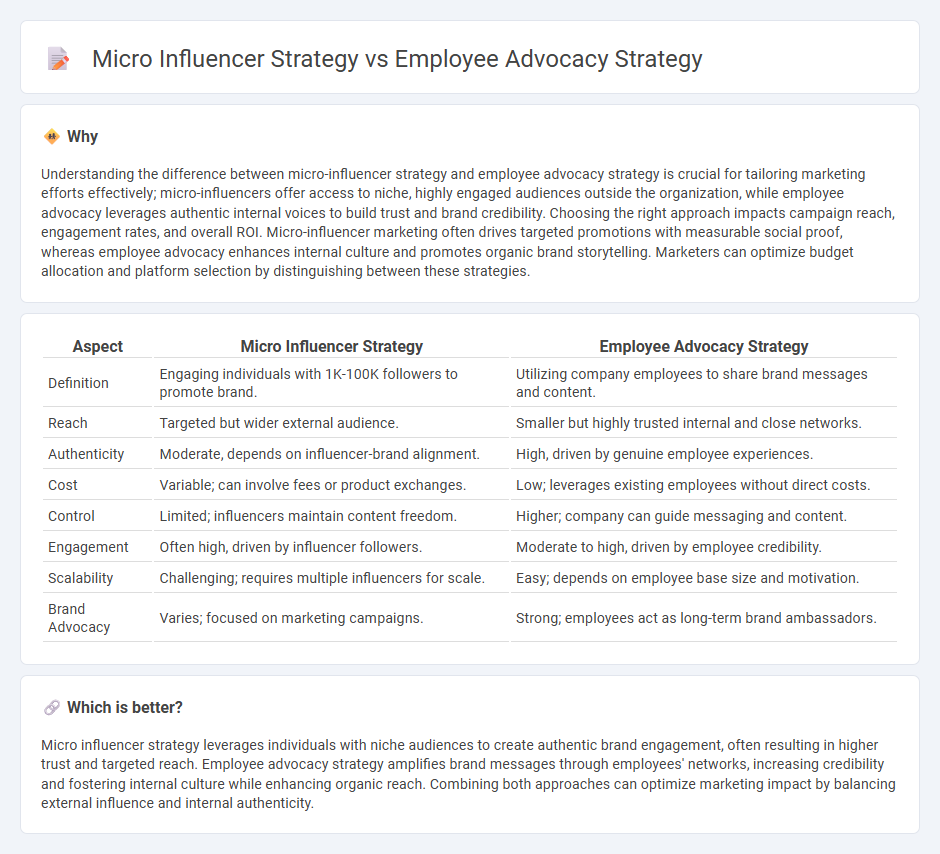
Micro influencer strategies leverage individuals with a niche yet engaged audience to promote brands authentically, resulting in higher trust and conversion rates. Employee advocacy strategies empower employees to share company content, boosting brand credibility and expanding reach through genuine personal networks. Explore how these tactics can enhance your marketing efforts and drive impactful results.
Why it is important
Understanding the difference between micro-influencer strategy and employee advocacy strategy is crucial for tailoring marketing efforts effectively; micro-influencers offer access to niche, highly engaged audiences outside the organization, while employee advocacy leverages authentic internal voices to build trust and brand credibility. Choosing the right approach impacts campaign reach, engagement rates, and overall ROI. Micro-influencer marketing often drives targeted promotions with measurable social proof, whereas employee advocacy enhances internal culture and promotes organic brand storytelling. Marketers can optimize budget allocation and platform selection by distinguishing between these strategies.
Comparison Table
| Aspect | Micro Influencer Strategy | Employee Advocacy Strategy |
|---|---|---|
| Definition | Engaging individuals with 1K-100K followers to promote brand. | Utilizing company employees to share brand messages and content. |
| Reach | Targeted but wider external audience. | Smaller but highly trusted internal and close networks. |
| Authenticity | Moderate, depends on influencer-brand alignment. | High, driven by genuine employee experiences. |
| Cost | Variable; can involve fees or product exchanges. | Low; leverages existing employees without direct costs. |
| Control | Limited; influencers maintain content freedom. | Higher; company can guide messaging and content. |
| Engagement | Often high, driven by influencer followers. | Moderate to high, driven by employee credibility. |
| Scalability | Challenging; requires multiple influencers for scale. | Easy; depends on employee base size and motivation. |
| Brand Advocacy | Varies; focused on marketing campaigns. | Strong; employees act as long-term brand ambassadors. |
Which is better?
Micro influencer strategy leverages individuals with niche audiences to create authentic brand engagement, often resulting in higher trust and targeted reach. Employee advocacy strategy amplifies brand messages through employees' networks, increasing credibility and fostering internal culture while enhancing organic reach. Combining both approaches can optimize marketing impact by balancing external influence and internal authenticity.
Connection
Micro influencer strategy and employee advocacy strategy intersect by leveraging authentic, trusted voices within niche communities to amplify brand messaging. Employees acting as micro influencers create genuine engagement by sharing personal experiences and company insights, enhancing brand credibility and reach. Combining these strategies maximizes marketing ROI through organic content and peer-to-peer influence across social media platforms.
Key Terms
Employee Advocacy Strategy:
Employee advocacy strategy leverages company employees as authentic brand ambassadors to amplify corporate messaging, enhance trust, and increase reach on social media platforms. This approach fosters genuine connections by utilizing employees' existing networks, resulting in higher engagement and improved brand credibility compared to traditional influencer marketing. Explore effective practices and benefits of employee advocacy strategies to elevate your brand presence.
Brand Ambassadors
Employee advocacy strategy leverages internal employees as authentic Brand Ambassadors to amplify company messaging across personal networks, enhancing trust and engagement. Micro influencer strategy uses external influencers with niche, loyal followings to generate targeted brand awareness and credibility. Explore how aligning Brand Ambassadors can optimize your marketing impact.
Internal Engagement
Employee advocacy strategy leverages internal employees as brand ambassadors, enhancing trust and authenticity through genuine content shared within their personal networks, which drives deeper internal engagement and corporate culture alignment. Micro-influencer strategy targets niche external audiences with influencers who have smaller, highly engaged followings, focusing more on external brand awareness rather than internal employee involvement. Explore our detailed comparison to understand which approach best boosts your company's internal engagement and external influence.
Source and External Links
Employee Advocacy Guide: Create a Winning Strategy - Sprinklr - This guide outlines seven steps to build a successful employee advocacy program, including cultivating workplace positivity and setting clear goals and KPIs.
What Is Employee Advocacy and Does It Really Work? - Sprout Social - The article discusses strategies for employee advocacy, emphasizing the importance of maintaining consistent content and using employee advocacy tools to streamline efforts.
Employee Advocacy in 2025: Everything A Leader Needs To Know - Vantage Circle - This resource provides insights into building an effective employee advocacy program, focusing on leadership buy-in, setting goals, and identifying advocates.
 dowidth.com
dowidth.com